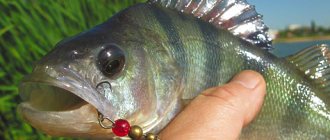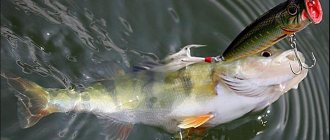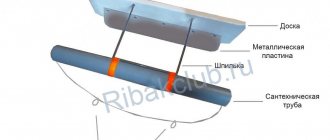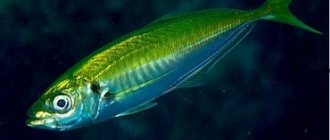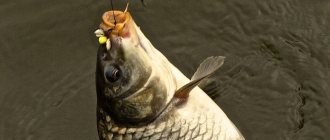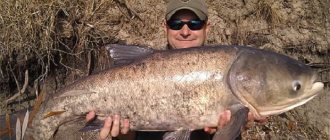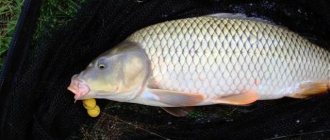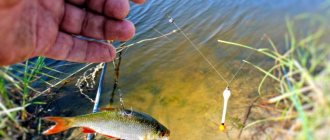Fishing with a goatee
Fishing with a beard is very similar to fishing with a spinning rod. Casting is done in the same way, but the load must lie on the bottom. I waffle at the bottom, in half-water, and at the top, moving slowly and with stops, without lifting the load from the bottom. When the bait stops, it floats up, and the same impression is created as when a fry plays.
When fishing with a fly rod, the barb is pulled sharply and quickly in the upper layer of water, and when fishing with a track - the same as when fishing with a spinning rod.
Fishing with Borodka | Tackle Beard | How to make a beard
Author: Nik | Date: March 30, 2011 | 716 | no comments
The beard, along with the foam fish, can be considered an original domestic invention. Although, perhaps this bait has analogues in other countries. In this post I will tell you what kind of bait this is - “Beard”, what design features it has, varieties and methods of fishing with a beard.
A barb is a combination of a “body”, a body and a fluffy tail, mounted on a hook (single, double, triple). The body can be either floating, made of polystyrene foam, cork, etc., or regular – cambric of different colors. A wide variety of materials can be used as a tail, but most often it is: goat hair, rain, lurex, colored threads, etc.
As you understand, by combining bodies and tails of different shapes, sizes and colors, you can create the widest variety of beards. Such flexibility and ease of manufacture are the main advantage of Borodka’s bait.
Large, voluminous, and sometimes composite barbs can be used as independent baits. But most often, a barb is a bait with minimal weight, which is why they are used in rigs with a separate sinker. A classic example of such equipment is bottom spinning, drop-shot, etc. That is, a sinker is attached to the end of the main line, and a leash or leashes with barbs are attached just above. Leashes are made from thin fishing line, as it is important not to scare the fish with a coarse leash. And since pike are not often caught on a specialized basis with a barb, they do without metal leashes.
Wiring tackle with barbs is quite simple. By controlling the line at the bottom with a sinker, they play along with the rod, giving the barb various animations.
The beard is considered a classic pike perch bait. However, perch bite very well on smaller barbs. It’s not uncommon to catch a pike on a ford, at the same time when catching pike perch or pike perch.
“20 steps from a complete beginner to a confident beginner in FISHING”
It will be extremely useful for beginning fishermen. But not only that. I have collected the most important components of fishing skill and presented them clearly, systematically, “without water.”
Find out details
nik-fish.com
Tackle for spinning predator fishing “Beard”
“Beard” is very popular among fishermen in the Kyiv region. With its help you can catch pike, pike perch, asp, perch and other predatory fish. Among the non-traditional trophies are saberfish, chub, and ide. The “beard” itself is not the key to success; it is only part of the tackle for catching these fish. If you want to try fishing with a “barb”, you will need a medium-hard spinning rod with a length of 2.5-2.8 meters, an inertial reel of the “Nevskoy” type, a main line with a diameter of 0.6 and a leader line - 0.35-0.40, black strong single or treble hooks, ball-shaped sinkers weighing 32 grams. The “beard” is crocheted. It can be made from bird feathers, beaver fur, sheep wool, cat hair, but best of all - goat or goat. To do this, you must first make a bunch of hairs of the same length, evenly cover the hook with it, coat the wool closer to the ring of the hook with glue and wrap it tightly with threads, on which again apply a thin layer of glue. If, after the “beard” has dried, you try to pull out a few hairs from it, but it doesn’t work, then the bait is made well. At different times of the year, fish prefer “beards” of different colors.
The “beard” can be mounted with a foam float (Fig. 1, a) or with a white cambric (Fig. 1, b), which some fans prefer to cover with thin candy foil. You can add 1-2 strips of New Year’s “rain” to the bundle of hairs. “Beards” can be equipped with oscillating and rotating spoons, but in this case the wool should be half as long (Fig. 2, a, b).
Assemble the tackle as follows:
First option. The fishing line is passed through all the rings of the spinning rod, after the tulip there should be one and a half meters of free fishing line to which the tackle is attached. First, two leashes, also made from fishing line, are tied to the main fishing line, they are threaded through the floats, and hooks with “barbs” are connected to the ends of the leashes. Then the floats are moved to the shanks of the hooks. Using a swivel, the sinker is attached (Fig. 3, a).
Second option. The sinker is connected to the main fishing line using a pin-fastener, to which a metal leash is also attached, and to it - a leash made of fishing line with a float and a “beard” (Fig. 3, b). In both cases, the tackle is cast and allowed to sink to the bottom. Then raise the tip of the rod, moving it slightly to the side, and wind the excess fishing line onto the reel. In three short jerks, the tackle is moved along the bottom, the excess fishing line is again selected - and so on until the tackle appears near the shore. In the water, the “beard” moves irregularly and thereby attracts a predator. This is how they mainly catch perch and pike perch. If the hunt is for pike, then the reel is rotated slowly and the tackle is slowly dragged along the bottom. During the reeling process, you can stop the tackle for 1-2 seconds and then start reeling again.
The third version of the tackle is used for asp fishing. It does not submerge in water, but remains afloat thanks to a large cone-shaped float made of cork or foam with a built-in sinker. It is better to use “barbs” with cambrics on such tackle (Fig. 3, c). After casting, the tackle must be slowly reeled in. The bite is visible visually and is similar to the fight of an asp; it is felt through the fishing line as a jerk.
Equipment Features
The specific structure of the gear fully corresponds to the name. It is based on several leashes with very small baits, which are most often made independently. The standard equipment of the barb includes three leashes. Standard fishing rigs that contain a spoon or wobbler are supplemented by some fishermen with a barb. The leash with additional small bait is located 20-30 cm above the spoon.
Today's manufacturers of spinners or wobblers often include tees or barbs or threads in their equipment. Many anglers retrofit their baits in this way on their own.
Equipment Features
The specific structure of the gear fully corresponds to the name. It is based on several leashes with very small baits, which are most often made independently. The standard equipment of the barb includes three leashes. Standard fishing rigs that contain a spoon or wobbler are supplemented by some fishermen with a barb. The leash with additional small bait is located 20-30 cm above the spoon.
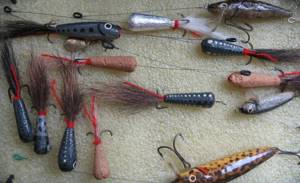
Today's manufacturers of spinners or wobblers often include tees or barbs or threads in their equipment. Many anglers retrofit their baits in this way on their own.
Installation of equipment and necessary gear for chinfishing
The equipment in question is made from decoratively disguised hooks. For manufacturing, a tee, double or single hook can be used. Each option has its pros and cons. The best choice in this case is the use of doubles.

To design a beard, sheep or cat hair, bird feathers, and beaver fur can be used. But most often, fishermen use goat hair. A small bundle must be attached to the hook and wrapped with thread. After applying a small amount of waterproof glue to the winding area, you need to wrap the winding area with thread again. You can add elements of New Year's rain tinsel to the equipment.
Foam plastic can be used as the body of a small bait. This equipment option is most suitable for asp hunting. When fishing for perch, it is advisable to cover the forend of the double with a piece of cambric, and when fishing for pike perch, it will be most successful if you use pieces of paralon.
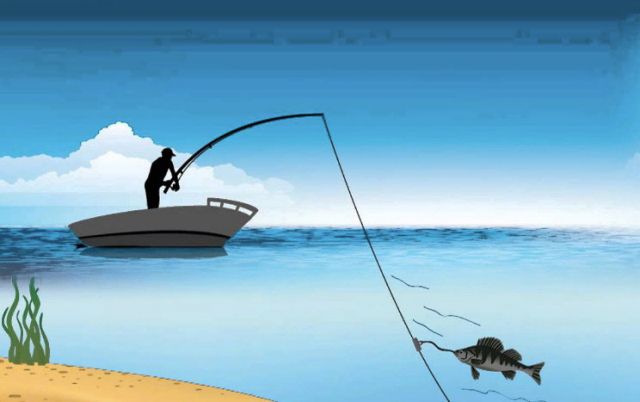
For barb fishing, it is convenient to use a rod 2.7-3.3 meters long, equipped with an inertial Neva-type reel. This type of tackle allows you to make long casts with this rig. As the basis of the tackle, you can use a fishing line with a diameter of 0.4-0.6 mm, and for leashes - 0.25-0.35 mm. When fishing for asp, instead of a weight, it is convenient to use a piece of dense foam plastic with lead poured inside. With this equipment, the bait is presented to the fish in the surface layer of the reservoir.
The “Beard” rig is a fishing secret of a spinning rod player, which makes it possible to catch predators in moments of their passivity.
The boat, baited with live bait, is launched across the current, bypassing the area where the asp is fighting (from behind). In this case, they are caught on leashes attached to the main line at a distance of at least 5-8 m from the boat, otherwise the latter can frighten the fish with its impressive appearance. The leashes should have a diameter of 0.3-0.35 mm, single hooks, No. 3-6, with a long shank. To attract the attention of the asp, live bait should be occasionally raised above the water. The catamaran boat model is most suitable for this fishing technique - it is less noticeable.
There are designs of boats, including a mast-mounted one, that are launched downstream from the boat. They should not be too massive so as not to arouse the suspicion of such a cautious predator as the asp. This is especially important if it is necessary to stop the boat at promising points. In this case, the current will put pressure on the body, and the unnatural position of the object on the water will alert the fish. In the design of a mast boat, two types of leash equipment are used. The first is when the leashes are attached to a fishing line in front of the boat. The second is when the leash comes from the hull of the boat. In the first case, the leashes must be placed as far as possible from the hull of the boat. In the second case, a long leash of at least 5 m is used, additionally equipped with a horizontal float that is hardly noticeable on the water. When launching a boat into the water from a boat, using the current, unfold a long leash so that it, along with the baited fry, floats right in front of the boat. To do this, pull the fishing line to slightly slow down the speed. If the boat is ahead of the movement of the additional leash, this will lead to tangling of the equipment.
All leashes are equipped with swivels, which prevents the line from twisting. It is better to take a large bleak or small roach as live bait. Live bait should be located close to the surface of the water. They bait it behind the upper palate, closer to the hard part of the head, otherwise it will not sit firmly on the hook.
The asp bite is sharp. Usually he captures live bait right away. When dragged to the boat, the asp violently resists, so it is advisable to purchase hooks, swivels and snap hooks for equipment from well-known manufacturers.
When catching asp on a boat, you can also use artificial baits - wabik, vibrotails, twisters. Especially artificial baits showed themselves well when fishing with a boat on the Lower Volga. Vabik is suitable white-black or white-green; high-quality wabik is made from goat hair. It needs a tee No. 8-13.
On medium and small rivers, medium-sized asps, up to about 1 kg, are well caught on a boat. They bite well on various flying insects: dragonflies, butterflies that emerge from aquatic larvae such as cuttlefish, barnacles, caddisflies, mayflies, etc. One of the best baits for a medium-sized asp is the gadfly. Sometimes, in order for the bait to be better visible on the water, it is worth putting two gadflies on the hook at once, but so that the insects continue to move and work with their wings. Any natural fluctuations in the water attract the attention of a predator. Small butterflies also need to be put on the hook several at a time.
On small rivers, Upa, Zusha, Ugra, Shosha, you can successfully use an inconspicuous boat drifting downstream. Usually this is walking fishing. You go downstream, choosing the bank of the river from which it is more convenient to launch the boat. Any protruding toe or just a regular shore with a comfortable step near the water, from which comes a powerful breaker jet, suitable for releasing the boat, is suitable for the angler’s position.
Streamer for asp
A barb or streamer is a fishing tackle used in fly fishing. Its appearance imitates a living fish, mouse, tadpole or frog. All those living creatures that predatory fish love to feast on.
Nozzle structure:
- hook with a long shank;
- body;
- tail;
- wings.
You can make a beard yourself or purchase a ready-made one. For knitting this type of nozzle, natural or synthetic fibers are used. This can be rabbit fur, goat or other animal wool, poultry or stork feathers, or artificial fibers.
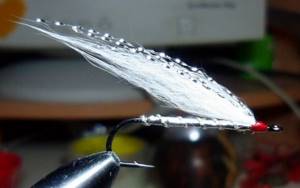
Photo 1. Homemade streamer beard.
In water, all these materials hold volume well and vibrate like living organisms. But each of them has its own characteristics:
- Fur and wool have poor windage when casting, but their movements under water are the most natural.
- Feathers in the water move smoothly, their trajectory is uniform. This is an excellent bait for asp. Feather barbs are suitable for bodies of water with fast currents.
- Synthetic materials in water are not as voluminous as natural ones. Their significant disadvantage is that they do not work well in fast flows.
To make the body of the beard, ordinary foam is most often used. Sometimes a shiny “rain”, silver foil and other “attractions” are added to the tail. The color of the beard is selected depending on the season and type of fish. The best streamer colors for catching asp:
- black;
- white;
- grey.
The length should be from 50 to 80 millimeters. Asp can also be caught using a beard made of red material. It reacts better to monochromatic tones.
Asp beard: what is it and how to catch it correctly?
Fishing for asp has its own characteristics. This predator has cunning habits, and a successful catch depends on the knowledge and dexterity of the fisherman. Tackle plays an important role. Experienced fishermen advise fishing with a spinning or match rod. The best bait for fly fishing is an asp beard. A predator will definitely be interested in “live” bait if it is correctly selected and used.
Streamer for asp
A barb or streamer is a fishing tackle used in fly fishing. Its appearance imitates a living fish, mouse, tadpole or frog. All those living creatures that predatory fish love to feast on.
Nozzle structure:
- hook with a long shank;
- body;
- tail;
- wings.
You can make a beard yourself or purchase a ready-made one. For knitting this type of nozzle, natural or synthetic fibers are used. This can be rabbit fur, goat or other animal wool, poultry or stork feathers, or artificial fibers.
Photo 1. Homemade streamer beard.
In water, all these materials hold volume well and vibrate like living organisms. But each of them has its own characteristics:
- Fur and wool have poor windage when casting, but their movements under water are the most natural.
- Feathers in the water move smoothly, their trajectory is uniform. This is an excellent bait for asp. Feather barbs are suitable for bodies of water with fast currents.
- Synthetic materials in water are not as voluminous as natural ones. Their significant disadvantage is that they do not work well in fast flows.
To make the body of the beard, ordinary foam is most often used. Sometimes a shiny “rain”, silver foil and other “attractions” are added to the tail. The color of the beard is selected depending on the season and type of fish. The best streamer colors for catching asp:
The length should be from 50 to 80 millimeters. Asp can also be caught using a beard made of red material. It reacts better to monochromatic tones.
Equipment
To catch asp with a beard, a spinning rod is used. It should be of normal rigidity, from 2.5 to 3 meters long. You will also need the following items:
- coil, necessarily inertial;
- main line (0.6) and leader line (0.35-0.40);
- strong black hooks, triple or single;
- sinker weighing about 32 grams, spherical in shape.
The beard is crocheted. It is necessary to knit tightly so that the hairs cannot be pulled out. Mount the streamer with a white cambric or foam float. If rotating or oscillating spinners are equipped with a beard, then use wool that is half as long.
To mount the equipment, you need a 1 meter piece of fishing line. Swivels are prepared at its ends. One end is equipped with a regular swivel, and the other with a clasp. A spinner or castmaster is attached to a swivel with a clasp.
The first streamer is attached to a 5-7 centimeter leash 25-30 centimeters from the swivel with a clasp. The second streamer is a little higher, at the same distance and on the same leash. The main line is tied to the swivel without a fastener. When fishing with a spinning rod, to increase sensitivity, you can use a cord rather than a monofilament line.
Photo 2. Approximate equipment diagram.
Fishing technique
When choosing a fishing spot, you should use your own hearing. Where you can hear splashing on the water, there is definitely an asp. You can fish the place. It is better to choose the southern sides. In the upper layers of water, fish hunt from spring to winter. It is difficult to say exactly what baiting tactics should be used; in this matter there is nothing better than personal experience.
When catching asp, camouflage plays an important role. When fishing, this is a decisive factor, since the asp is a very cautious fish. He sees the fisherman perfectly in clear water and does not bite the bait. You cannot make noise, talk loudly, or stand at the water's edge at full height.
Photo 3. Catchable beards on asp.
With any fly fishing there are certain technical rules, without which fishing may not work. Initially, you need to grip the rod correctly. The grip with the thumb on top of the handle is very comfortable. To use the index finger in this position, you need to choose a light bit. Fix the cord with your left hand.
Casting Features:
- When swinging the spinning rod, the fly line should not fall down.
- To accelerate, pull up is used using the movement of the hand in which the cord is located.
- Using the “double pull” you can cast the fly up to 20 meters.
- If there are obstacles nearby, then a “ring cast” is suitable. This is a backswing in which the loop moves along the surface of the water. This method is not suitable for long casts.
When fishing on a river, the cast is made several meters further, against the current. The stream will pick up the bait and bring it to the probable biting zone. Big fish like to chase fast-moving baits. But they can change their hunting tactics.
Lake predators that are found in reservoirs are distinguished by their hunting tactics. They prefer to wait for prey in the depths of the riverbed. Small baits are suitable here. It is worth noting that asp are more difficult to catch in calm waters.
The fish makes exits at specific time intervals and moves according to an invisible pattern. Outputs are repeated periodically. It is important for the angler to calculate the gap and cast the bait at the moment after the fish strikes. The asp can get used to the bait. After 20-30 casts you need to change it or take a break.
Tips for successful fishing
At different times of the year, the asp behaves differently. The choice of location also depends on the season:
- In autumn and winter it is better to choose shallow lakes and shallow canals. These may be depressions, shallow estuaries or river banks.
- In summer, large bodies of water will be a suitable place. It is better to fish in thickets, on rifts, edges, and near stones.
In autumn, the fish are less active and move to quieter places. At this time, baits are chosen that are heavier than in summer. The bait is carried out at medium depth or along the bottom. This is due to a change in the asp’s hunting tactics. He begins to attack in deeper layers.
In winter it is very difficult to find asp. But during this period, weighty specimens are caught. Lucky fishermen who master the art of deep and slow fishing.
In spring, it is better to catch the predator in the morning. During the spawning period, it is difficult to find the asp during the day, although in other seasons it is active during this period of time. But it is in the morning that he is especially hungry and the likelihood of a good catch is higher.
In summer, especially from late June to mid-August, night fishing can also be successful. Many fishermen advise fishing before a sudden change in weather conditions, from good weather to bad. For example, before a thunderstorm, when atmospheric pressure jumps and the air is filled with heat and moisture.
The chosen time of day also plays an important role. Fish activity varies throughout the day:
- By 8-9 am the fish become active.
- After 13-14 hours activity decreases.
- After 16-17 hours it stops pecking.
Advice!
It is always worth remembering that the asp is unpredictable, and its activity can change without fitting into any framework.
In places with a bald coastline, the predator can go hunting in the evenings before sunset, when the wind subsides. At this time, insects appear above the water, which are caught by small fish. The asp attacks when these fish accumulate. Where there are many hanging trees over the water, the fish are active throughout the day.
Despite its caution, the asp is a very curious fish. It reacts to splashes and impacts on the water. With this you can attract it by making several blows similar to those made by the predator itself. Most likely, he will immediately sail to the place of the splash to find out what is happening there.
fishelovka.com
Equipment
To catch asp with a beard, a spinning rod is used. It should be of normal rigidity, from 2.5 to 3 meters long. You will also need the following items:
- coil, necessarily inertial;
- main line (0.6) and leader line (0.35-0.40);
- strong black hooks, triple or single;
- sinker weighing about 32 grams, spherical in shape.
The beard is crocheted. It is necessary to knit tightly so that the hairs cannot be pulled out. Mount the streamer with a white cambric or foam float. If rotating or oscillating spinners are equipped with a beard, then use wool that is half as long.
To mount the equipment, you need a 1 meter piece of fishing line. Swivels are prepared at its ends. One end is equipped with a regular swivel, and the other with a clasp. A spinner or castmaster is attached to a swivel with a clasp.
The first streamer is attached to a 5-7 centimeter leash 25-30 centimeters from the swivel with a clasp. The second streamer is a little higher, at the same distance and on the same leash. The main line is tied to the swivel without a fastener. When fishing with a spinning rod, to increase sensitivity, you can use a cord rather than a monofilament line.
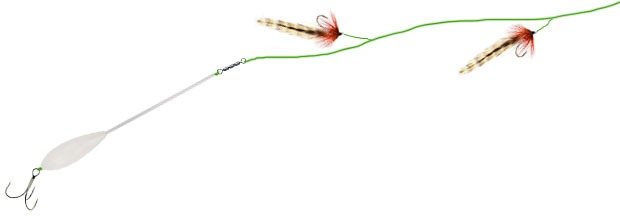
Photo 2. Approximate equipment diagram.
Installation of gear
If you fish with a streamer as an independent bait, then it is better to use ultralight gear. Its weight is only 1–3 grams. This method of fishing is relevant on small rivers, when a predator can be caught at close range.
Tip: Fishing with a streamer is effective in the summer under branches overhanging the water, along steep banks, at local points.
Much more often, asps are caught with a beard, using the same long-range gear as for fishing with heavy spoons - a tall spinning rod, a powerful reel, and a sliding line. It is important to assemble the equipment correctly. The basic installation option is as follows:
- A leash up to 1.5 meters long is attached to the main line.
- At its end we attach a swivel with a fastener for a jig or other heavy bait.
- 30 cm from the end of the leash we make a loop 1–2 cm long using a figure eight knot.
- We knit the second loop in the same way, again retreating 30 cm. If desired, make a third after another 30 cm.
- We make short bends 10–15 cm long, at the ends of which we tie wabiks.
- We mount them to the leash using the “loop-to-loop” method.
Recommended reading: Catching perch in winter with a baitfish
That's it, a simple assembled beard. Its advantage is the absence of unnecessary elements and minimal cumbersomeness. During casting and movement in the water, the equipment does not get tangled, remaining attractive to the asp.
Some anglers attach double and triple swivels to the main leader to minimize line twist. This saves the equipment from possible tangling, but reduces its strength. Increases the requirements for each of its elements and the quality of knitting knots.
How to properly catch an asp using a goatee
Catching an asp with a beard is effective only if you choose the right promising location. It's easy to find by sound. Sheresper hunts fry in a specific way - first he stuns them with strong blows of his tail, and then calmly grabs the small thing, which temporarily loses its orientation. In places with splashes on the river there is a high probability of finding a flock. By making an accurate cast to a promising place, the asp can attack the bait with its tail. Previously, a durable streamer was specially made so that the sting would not be exposed during an impact.
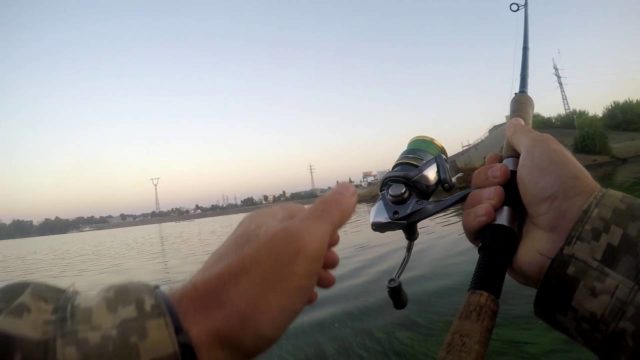
Fish hunt in the upper layers of water from spring to winter
When choosing a location, it is preferable to look at the south side. Casts are made in the upper layers of water in the warm season, but in the heat the predator sinks deeper (2-3 m). You can find asp from above in spring and autumn (during the warm periods of the seasons), as well as in summer. The best time for fishing in summer is morning and evening, when the predator goes hunting.
An important condition for successful fishing is camouflage, since upon detecting an angler, the fish will immediately move to a safe distance. The asp has good eyesight and notices a person from afar; any bait turns out to be ineffective. The noise will also prevent you from catching wary fish.
Technique for catching asp with a beard
The primary task of the fisherman is to take the rod correctly and comfortably in his hand. Many people grip the fishing rod with their thumb on top of the handle. Casting with a heavy rod is inconvenient, so we recommend choosing an ultra-light spinning rod. The other hand fixes the cord (especially important in fly fishing).
How to cast correctly:
- the line should not fall while the rod is swinging;
- when retrieving, you can use a reel, smoothly pulling the line by hand;
- in the case of “double pull-up”, it is possible to cast 20 m without a sinker with only one fly;
- if there are obstacles on the shore, ring casting is used. The swing is made from behind the back, the rod is held in an inclined position so that the bait flies along the water. It will not be possible to make a long cast using this method.
If fishing is carried out on a reservoir with a current, the cast is made 5 m upstream. The bait will go down the stream straight to a promising place. The asp loves to profit from active prey; the bait floating downstream lulls the vigilance of the fish and provokes it into a sharp attack. It is important to make an accurate cast, otherwise the fisherman will not notice the bait and the casting will be ineffective.
Asp are found less frequently in still water and have different hunting tactics. It tends to hide behind snags, supports of hydraulic structures, algae, etc., and then suddenly attack the victim. In reservoirs with calm water, fishing becomes more difficult.
The asp prefers to move along the same routes; the fisherman’s task is to calculate these paths and cast ahead. Observation of splashes of water will help determine the pattern.
Additional tips:
- It is important to choose the right fishing time. In summer, the best bite occurs from dawn to 10 am and from 6 pm to sunset, and at night the asp is not active. In spring and autumn, when the water is cool, the sheresper hunts during the day; the best bite begins at 10 o'clock;
- the predator gets bored with the same baits. After 20-30 casts, change the bait and take a short break;
- in cold and hot weather, the fish prefers to stay in holes; it is most effective to deliver bait to a depth of 2-5 m.
To catch an asp, special tactics and the right tackle must be used, otherwise the cautious fish will stop feeding altogether or swim away. You won’t find asp close to a crowd of people; it’s better to choose secluded places with a fast flow of water, reverse flow, rocky bottom on the rifts - these are the favorite places for hunting prey.
Tackle and bait for asp fishing with spinning rod
They use bleak or verkhovka as bait. You can use rotating spoons, spinners, triangular spoons, Devon with two propellers, wobblers.
Wobblers can be different; the method of using it depends on the type of bait:
- Heavy, sinking wobblers with a long-distance casting system can be cast exactly to the place where the asp is hunting.
- Suspender wobblers are released behind the boat over long distances, including to fish hunting areas.
- Floating wobblers are sent from the boat downstream.
If the asp does not take the bait, a floating wobbler is lowered to a line length of 50-80 m and ply the boat without approaching the location of the fish. If you approach the asp hunting area by boat closer than 50 m, the “river corsair” will move further.
In case of fast currents and riffles, the boat is stopped above 50 m from the riffle, the wobbler is sent downstream to the riffle hole, then slowly pulled up. You can use a spinning rod and make long casts using a spinner.
Bombarda (sberulino)
One of the most popular ways of catching asp is fishing with a bombard.
A bombard is a tackle that is a special float (sberulino) with a leash with bait or lure attached to it.
Bombards can be different: floating, sinking, quickly sinking. A bombard is the best tackle that allows you to hunt asp in all layers of water and make long casts.
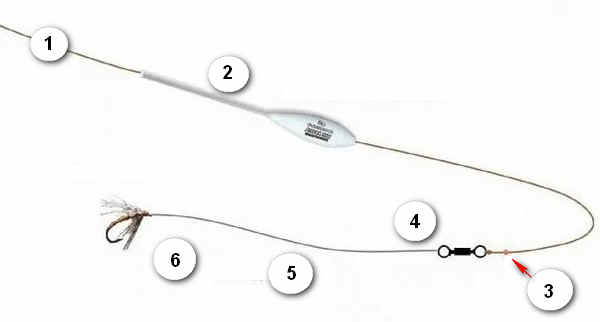
Bombard structure: 1. Main line. 2. Bombarda. 3. Bead. 4. Swivel. 5. Leash. 6. Bait.
A short video about the device of the sberulino (bombard):
To make the tackle, you need a long spinning rod, a braided cord, a bombard and a bait. In this case, the weight of the bait should be less than the weight of the bombard. When casting, it is important to slow or stop the unwinding of the braid before the bombard hits the water. As a result of this, the bait will overtake the bombard, and the equipment will lie flat on the water.
Bombards are in great demand among fishermen, allowing them to fish both on the surface of the water and in the depths or at the bottom. Many fishing enthusiasts are familiar with bombards, which differ in their weight, size and density of material. Depending on the density, they remain on the surface of the water or go into intermediate layers, or immediately sink to the bottom. A bombard with a density greater than the density of water is immersed in water very quickly. However, unlike a heavy metal sinker, it sinks without being noticed.
Lures, baits
Baits play an important role when catching this fastidious predator. Along with natural baits, fishermen widely use artificial ones, which allow them to reach fish from a long distance and perform an accurate cast. Catching asp with artificial baits is no less effective than with natural baits, since their special design easily enters the layers of water and jumps along the surface, thereby stimulating and attracting fish.
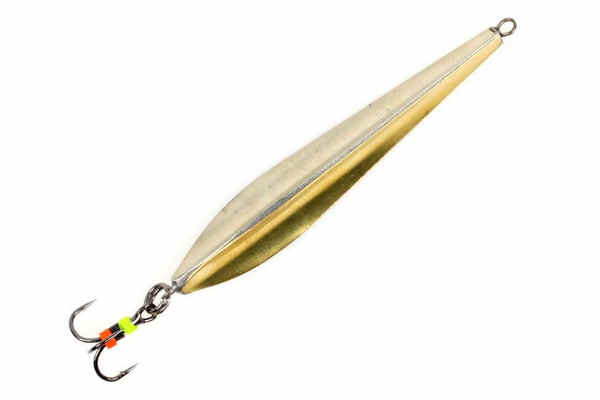
The most popular baits include the classic triangular spinner.
This bait differs little from bleak, the asp’s favorite food, and helps to get a rich catch.
When catching asp, white flies of various types are used. The maximum effect is achieved by combining several flies. A correctly tied fly in the water seems to come to life: it moves its legs, wings, and tail. The fisherman lowers and holds the bait in the current, after which the fly either expands or contracts, thereby provoking the fish to action.
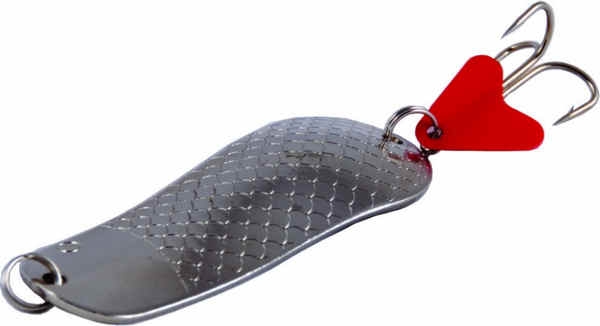
No less effective is the method of fishing with a “oscillator” - an oscillating spoon.
Wiring is carried out across the stream or under demolition. With this method, the bait combs a fairly large area of the reservoir, reaching the upper and lower points. You can move the spoon against the current, this will tease the asp walking along the stream. Fishing under a splash is also possible; the bait is sent exactly to the place where the “river horse” was discovered. But this method is advisable in slow flows, when the fish hunts without fuss and haste.
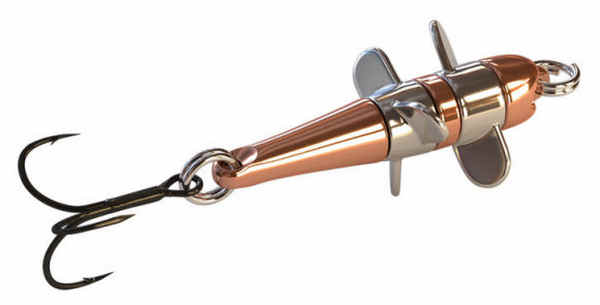
Devon combines all the advantages of rotating and oscillating nozzles.
One of the types of artificial baits when fishing with a spinning rod is Devon. It provides an ultra-long casting distance, easily reaches the upper layers of the water, imitates a narrow-bodied fish and provides a vigorous play of the blades. This attachment will not leave the fastidious and cautious asp indifferent.
Features of catching asp on a spinning rod in spring
Catching asp with a spinning rod in the spring has its own characteristics. During this period, the fish comes quite close to the shore. However, due to the excessive caution of the asp, it is better to catch it while camouflaged in sober, neutral colors that do not attract attention. If a predator ignores the bait, you need to hide behind a stone or a bush, or move further away from the shore and cast from this distance.
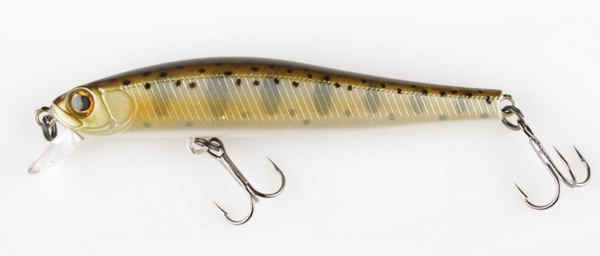
A bleak or a floating wobbler, reminiscent of this silvery fish, is perfect as a spring bait.
A floating wobbler works very effectively; it can float with the current and go long distances. It can easily be directed under snags and other places where it is difficult for other baits to reach. It will also be good to catch asp on surface poppers and stickbaits. You can fish with these baits as early as April.
When catching asp in the spring, you should give preference to silver and blue baits. On fine days and daylight hours, blue baits with silvered sides will be of great benefit. In the evening, take orange or red bait.
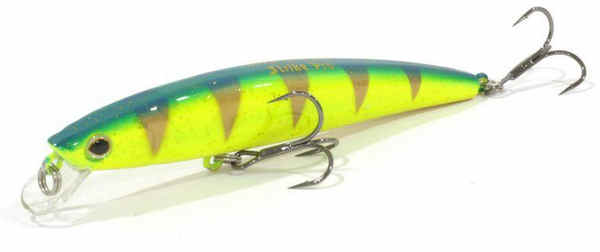
At night, fish react to luminous baits of various colors.
Fishing in May
Spinning fishing in May very often pleases the fisherman with a good catch. During this period, the asp had already spawned and began to regain strength. You need to look for it first of all in shallow water and choose mainly rivers with fast currents and numerous riffles for hunting predators.
The post-spawning feast lasts until mid-May. In good weather, active biting can continue for several days. Spawned asp can be found near underwater islands formed in flooded areas of uplands. The depth in such places reaches a maximum of 2.5 m. On the island itself, the chances of meeting a “river horse” increase. It usually lives on the border of direct or reverse currents. He also loves areas with flooded vegetation.
In May, the asp becomes very cautious, so you should catch it at a distance of no closer than 15 m. If the fish is found near the shore, a 3 m long rod with any fishing line is suitable for fishing. The reel must be high speed.
The bite in May is quite greedy, so the asp hooks itself at this time. After the bite, he goes to the side, unwinding the line from the reel, but quickly gets tired and returns after the line. Near the shore it tries to escape again, so you need to have time to loosen the tightly stretched cord, after which, having completely lost strength, the asp falls on its side and falls into the landing net.
You cannot jerk the line sharply, as the predator grabs the bait only with its lips and hangs on the hook stuck in the lip. When the fish moves suddenly, the hook flies out and the asp escapes safely.
The main task of the fisherman is to find the habitat of the predator and select the right bait.
Retractable leash for pike perch: installation and fishing
Pike perch itself is quite unpretentious and careless, so many beginners seem to be an easy prey, but this fish reacts to any meteorological changes, for example, with low pressure it becomes passive and the fisherman has to adapt to its mood, in which case catching pike perch on a retractable leash helps . This is an almost universal tackle that allows you to get not only moral pleasure and relaxation, but also take another trophy to your collection. The main advantage of such equipment for pike perch is that it is convenient to use for deep-sea fishing with donka, and it also shows good results as bait on rivers and lakes. So what mistakes should you avoid when installing a diverter leash for catching pike perch?
Benefits and methods of creation
In order for you to understand why you should learn to use such equipment for catching pike perch, you should understand its strengths, including:
How to catch pike perch by catching up
When we have ready-made equipment, the only thing left to do is find a hunting spot for pike perch. But everything is simple only in words. In fact, those anglers who know how to look for walleye understand that it is not always an easy task. Especially on an unfamiliar body of water.
But when you know where the pike perch is hiding under the ice, catching it is not difficult. The technique of catch-up fishing and wiring is no different from the standard one. At the same time, the equipment works even if the pike perch is inactive and does not want to take on other pike perch equipment.
This may include:
- Jig game;
- Short jerks followed by a fairly long pause;
- Combinations of various playing techniques.
Each time you have to look for the most effective wiring technique, adapting to the activity of pike perch or pike.
The following video will help you understand how to catch pike perch using the equipment described above in practice.
Winter catch-up fishing for passive pike perch:
How to increase your fish catch?
Over 7 years of active fishing, I have found dozens of ways to improve the bite. Here are the most effective ones:
- Bite activator . This pheromone additive attracts fish most strongly in cold and warm water. Discussion of the bite activator “Hungry Fish”.
- Increased gear sensitivity. Read the appropriate manuals for your specific type of gear.
- Pheromone -based lures .
- High activity. A retractable leash on a pike perch can stir up the prey, forcing it to attack even the most attractive bait. But, naturally, this does not give you a reason to relax and hook any gear onto leashes, but it opens up the field for experiments that will not greatly affect your catchability.
- Universal. The tackle performs well both in currents and in calm waters, is convenient in the cases already described above, and most importantly, it opens up a whole world of completely new baits for you.
- Simple and interesting fishing allows you to use the most convenient methods of hooking fish.
But the freedom that fishing with a retractable leash provides in choosing other elements is still partially limited, because long spinning rods and baits in which the fastening occurs using a cord will have the greatest effectiveness in conjunction with tackle. Using this combination is the kind of advice that professionals often give to inexperienced beginners. All this must be selected according to certain algorithms and taking into account the weight and size of other equipment, as well as fishing conditions. So, it is better to fish from the shore using long, but not very heavy spinning rods, while on a boat you can take short gear, but with a shifted center of gravity, which will open up new fishing methods for you.
Why is the tackle so attractive to predators, especially if Carolina is used with it? The fact is that the main way of fishing with a retrieve is to hit the bottom with a weight, which will attract your prey. The pike perch will begin to attack and end up on your hook, but to do this, you should use a stepwise retrieve method, which will allow you to imitate the movement of the fry as accurately as possible, and thus the bait will become even more attractive to the predator.
If you have spent time studying certain methods of fishing with a leash and practiced separately, while doing each element correctly and honing it to perfection, then the catchability of almost any bait will increase significantly.
Light baits are best suited to such gear, and with the latest trends in the world of fishing, silicone edible bait is also becoming popular. If for some reason you do not have the opportunity to buy leashes or you want to give them some specific characteristics that manufacturers cannot provide, then making a retractable leash with your own hands is not a difficult task. Unlike most baits, you don’t need any specific skills in processing iron or wood, and you’ll spend little time, and fishing will become easier and more enjoyable.
But now you have a ready-made element in your hands, how can you install the equipment so as not to regret the time and resources spent on its production?
First option
There are two most popular methods for installing leashes, in the first case:
- You will need to use a sinker and jig with a small foam barb.
- Once all components have been assembled, installation can begin. To do this, attach a “tee” to the main fishing line. This is where beginners make a lot of mistakes, but attaching a swivel is actually quite easy if you practice a little. A right angle should form from the eyelet.
- Next, the main leash is inserted into this eyelet and attached. Almost all experts, as one, will advise you not to cheap out and take fluorocarbon fishing line; those who have fished on leashes, even with braided ones, know that a predator can easily bite off the bait with a piece of fishing line and leave you without a piece of gear.
Try to mount a foam bead in advance; polystyrene foam is also suitable as a material, but it is usually more difficult to obtain. Naturally, you can use other light baits, but this one will serve as a “control”, from which you can then measure the effectiveness of wobblers and spinners, selecting the best option. Two ears take up the gear, and the third one is attached to the leash itself, up to 0.6 meters long, to which you will later attach various baits.
Second option
In this case, the fastening has much more nuances, and it is less reliable, because we are trying to build a fairly neat structure, the main purpose of which is to catch small fish for further preparation for live bait.
Here you will need to prepare the following gear:
- a pair of carabiners, with the help of which the main fastening will take place;
- weights up to 12 grams weighing in the shape of a cylinder; if you cannot find such, you can replace them with ordinary pellets, but catchability will suffer slightly.
In this case, you can also use a silicone leash, because small fish are unlikely to require the strength of fluorocarbon, but many professionals prefer to play it safe if they suddenly decide to bite a trophy exhibit. Next, one eye of the swivel is attached to the main fishing line, and into the third you pass a pre-cut piece of tackle up to 25 centimeters long. It doesn’t matter here whether the fishing line is monofilament or silicone, the main thing is that it can withstand the loads that even small fish will put on it.
The ends of the fishing line are tied with a nautical knot, but some also use triple knots, depending on which is more convenient. The loop that is formed as a result will serve as the connecting part between the swivel and the sinker.
We use the free eye to attach the leash, as in the previous case, on which the silicone hook should be located. If you find a strong river current, you can always attach a shot to the hook, which will stabilize the bait.
Making your own amphipod
Now amphipods can be easily purchased in almost any fishing store. However, some people prefer to make amphipods for pike perch with their own hands without the use of expensive materials. I'll tell you about several ways.
Beard on a reel, fishing incident
I remember it was in the fall, and nothing foreshadowed an incident or an unusual situation. I went fishing on one of the rivers that feeds the Volga. The river is very interesting, because starting from the village (I don’t write the name so as not to cause an influx of lovers to these places; I am of the opinion that each fisherman himself should discover his own place), it expands sharply, the average depth is already 2-3 meters, and it becomes possible to fish not only with surface baits and baits moving in the middle layers of water, but also to fish perfectly with a jig (using light sinker heads).
Since I had been on the river since early morning, and had a whole autumn day ahead, I decided to walk downstream about 7 kilometers to the bridge, cross the bridge there, and call my friends, who would pick me up. In general, everything is great.
In my backpack I put a supply of baits, sinkers, hooks, food, a thermos and other belongings that are necessary for a person who decided to spend several hours of his life on the river bank, away from people. I took everything except the spare line, as I hoped that 80 meters of braid on the spool was more than enough. In principle, in most cases, this is true. But, while fishing in one of the areas, I came across an interesting backwater, a kind of bay, where the depth was only about a meter, and the surface was completely covered with aquatic withered vegetation. I threw a spinnerbait and a Croatian egg there, and my efforts were crowned with a bite from a small bee, which safely escaped literally near the shore. It’s good that at least there was a bite. But while fishing in this place, I did not notice how small blades of grass somehow got wrapped around the spool, apparently slipped through the tulip, or, during reeling, some blades of grass were caught by the line guide. One way or another, there were foreign objects under the layer of braid.
And here it is, the next “key” cast of jig bait (foam rubber) to the middle of the river. I noticed that there was a sharp drop off the opposite bank, the current was creating breakers, so I wanted to send the bait as close as possible to this place. A strong swing, an effort, I release the braid fixed with my finger, I’m already anticipating the flight of the bait, and the bait... falls 3 meters from me, with a strong blow to the water, and a ball of braid hangs from the reel, in some places some knots are even visible. Needless to say, it immediately became clear that it would not be possible to untangle this beard just like that, although I honestly sat for 30-40 minutes and made attempts to untangle the tackle.
As a result, 20-30 meters of braiding had to be cut off. Of course, the remainder was basically enough for me to get to the bridge and leave the spinning rod, but my mood was pretty bad. Although, if you think about it, it was a lesson, and since then, in my backpack, especially when I go on long solo outings, I always have a spare fishing line (namely 0.3mm fishing line, the cheapest one on the market). As they say, there was experience, conclusions were drawn.
Well, to summarize, I want to say that any tackle requires not only skill and knowledge from the fisherman, but also attentiveness. If I had paid attention a little earlier to the fact that blades of grass and algae appeared on the spool, there would not have been a problem, but otherwise...
So, anything is possible when fishing, any gear can fail, but don’t be sad, because it’s a unique experience and adventure. By the way, that time I didn’t see any more bites, but I had a very good walk, which I wish for you too.
